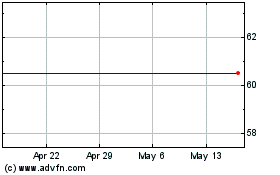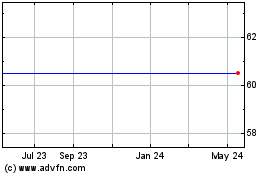By Ted Alcorn
A beetle no larger than a grain of rice is ravaging European
forests, infesting and killing trees faster than they can be culled
to slow the insects' spread. It turns out the best way to spot the
pests, and stop them, may be from space.
For years, Swedish forestry cooperative Södra has deployed
hundreds of foresters to walk the widely spaced spruce on
properties it helps manage, monitoring the trees' bark for drilling
holes that are a telltale sign of infestation. But it can take days
to assess a single 100-acre estate by foot, and Södra oversees more
than five million acres. Last year, the beetles damaged five
million cubic meters of lumber, about a quarter of the season's
potential yield, says Johan Thor, an applied physicist and head of
data science at the cooperative.
So in early 2019, Södra began working with the Dutch technology
company Overstory to find the beetles from above -- way above. By
matching high-resolution satellite imagery with geographic readings
of sick trees as recorded by the company's harvesters, and
integrating other satellite-derived data such as land-surface
temperature, they were able to train a model to quickly and
accurately locate infested areas. The complexity of the data --
with a profusion of tree species and canopy heights -- was "a sweet
spot for machine learning," says Overstory's chief executive
officer, Indra den Bakker.
"The preliminary results are really quite astonishing," says Mr.
Thor.
Mr. den Bakker estimates use of the technology could improve
Södra's efficiency at locating diseased trees by as much as 20%,
helping save its members hundreds of thousands of cubic meters of
lumber annually.
It is just one example of how high-resolution satellite imagery
and artificial-intelligence-driven analysis are changing how we
understand and interact with forests. Scientists say these
technologies on their own won't be decisive in preserving
biodiverse habitats or forestalling climate change -- but they make
possible a real-time awareness of the world's forests that past
conservationists could have only dreamed of.
Fire prevention
As California endures the most destructive fire season in its
modern history, state and federal agencies are adopting similar
technologies to assist in preparing for, suppressing and recovering
from wildfires.
Part of the reason fires in California have grown so large in
recent years is that the state has been overzealous in suppressing
naturally occurring fires that would clear underbrush before it
accumulates to dangerous levels. Forest managers say the only way
forward is to accelerate the pace at which areas of the state are
"treated" -- including through controlled burns and by thinning,
mulching or removing underbrush with heavy equipment. In early
August, the federal government and the state announced their shared
commitment to treat at least one million acres annually.
It is arduous for crews to identify where the forest is dense
and needs to be cleared, however, and agencies have typically
developed individual treatment projects of smaller than 5,000
acres, says Eli Ilano, forest supervisor for the Tahoe National
Forest. The advent of Earth-observation data has changed that by an
order of magnitude. In 2018, the U.S. Forest Service and other
partners initiated a project covering 275,000 acres of the North
Yuba watershed, relying largely on remotely sensed data and machine
learning to create the treatment plan -- without relying on staff
on the ground. "Compare that to years and years of crews and crews
of people out trying to characterize the landscape," says Mr.
Ilano. "It's much faster, it's much safer, it's much cheaper."
Fighting deforestation
Whereas foresters in California are working to prevent future
blazes, conservationists seeking to guard the world's tropical
forests are trying to hold businesses accountable for fires in the
immediate past.
Much of deforestation in these areas is driven by global
agribusinesses that source commodities like palm oil, soy and cacao
from hundreds of thousands of farms, some of which raze protected
forests to convert them into cropland. Conservationists have long
employed satellite imagery to flag incidents of deforestation and
name and shame the agribusinesses that profit from the
destruction.
Global Forest Watch, set up by the nonprofit World Resources
Institute in 2014, issues tens of thousands of deforestation alerts
every week.
As the number and type of Earth-observation satellites have
increased, Global Forest Watch's gaze has sharpened. The program is
currently integrating radar data, making it possible to peer
through the clouds that shroud tropical areas many months of the
year, and in September, Norway announced it would donate a new
stream of high-resolution optical data that will be updated
monthly, allowing for the identification of deforestation in closer
to real time.
"What you do with that flood of information?" asks Crystal
Davis, the director of Global Forest Watch. "How do you figure out
which ones matter most and which ones we should prioritize acting
on first, given limited capacities?"
Some big businesses are hiring private companies to help them
sift through the data. False positives are a problem because
without confidence in the alerts, "you end up not having either the
right conversation with the right supplier, or the most meaningful
conversation that you could be having," says Giulia Stellari,
director of global sustainable sourcing at consumer-goods giant
Unilever.
In March, Unilever hired Descartes Labs to whittle down the
deforestation alerts it receives, with a focus on palm-oil
production in Indonesia and Malaysia. Descartes used
machine-learning techniques to better distinguish between the
vegetation of forests that need to be protected and palm
plantations where fires and replanting are a natural part of the
agricultural process, says Cooper Elsworth, an applied scientist at
the Santa Fe, N.M.-based firm. That, he says, allowed Unilever to
narrow down 40,000 alerts in the first half of 2020 to just a few
hundred of particular salience and importance.
Of course, a complete picture of deforestation and the parties
involved is of little consequence if governments and companies are
unwilling to act on it. That is what worries Matthew Hansen, a
professor at the University of Maryland whose pioneering research
was the foundation of global-scale satellite-based forest
monitoring. The world loses some 67,000 acres of forest each day
due to inaction, "not because we don't have shiny enough objects in
space or fancy computing," he says.
The Amazon is a case in point. In the early 2000s, Brazil curbed
deforestation there by around 80% using technology that is
rudimentary by today's standards. Tasso Azevedo, one of the
principal architects of that effort, says it hinged on commitment
by the country's top leadership and real accountability for
violators. "The political will to solve the problem is much more
important than all the technology available," he says.
Based in São Paulo, Mr. Azevedo now leads a private initiative,
MapBiomas, that pairs satellite data with records of land tenure to
show not only where forests are disappearing but who is
responsible. He believes Brazil could halt deforestation entirely
if it acted on the information. But in 2019, deforestation in
Brazil hit the highest rate in a decade.
New markets?
Perhaps the most ambitious hope inspired by these advancing
technologies is that they will allow new markets to emerge that
price all of the natural benefits of the world's forests -- such as
sequestering carbon from the Earth's atmosphere and supporting
wildlife -- and harness resources to protect them.
To date, efforts to establish a sustainable trade in carbon
offsets have been hampered by doubts about how effective they are.
Investors balk at paying to protect forests they later find weren't
actually imperiled, or out of concern that by shielding some areas,
they are merely shifting deforestation to others. Carbon-offset
projects with inflexible terms -- demanding landowners set aside
their forests for decades or even a century -- haven't helped
either. Innovators, however, are betting that precise, real-time
estimates of forest carbon will change that.
In Pennsylvania, an experiment is under way to test that
proposition.
Max Lowrie, who helps his dad and brothers manage a tree farm on
145 acres, says he heard about a new kind of carbon offset last
year at a meeting of the Woodland Owners of Clarion-Allegheny
Valley. In return for forgoing a timber harvest this year,
landowners would be paid for the carbon their forests absorb -- but
unlike typical offset contracts that are only open to those with
huge holdings, landowners with as few as 30 acres could
participate, and they would be paid annually and allowed to revise
their contract each year. Combined, the participants enrolled
66,000 acres, and were expected to sequester 100,000 metric tons of
carbon-dioxide equivalent.
The 53-year-old Mr. Lowrie says that while he is concerned about
changing weather patterns, he wanted to participate in the program
because of the money. "It makes sense: We're doing something good
for the Earth, we should be rewarded for our work."
The project hinged on a map of the Pennsylvania forests of
unprecedented detail from SilviaTerra, a forestry-data company.
Using artificial intelligence to process an enormous amount of
satellite imagery of various types and time periods, the company
can estimate the size and the species of the trees based on factors
like when their leaves begin changing color in the fall.
Zack Parisa, SilviaTerra's CEO, says landowners are typically
paid for the only dimension of their holdings that can be weighed
and valued -- timber -- even if the same acreage creates
harder-to-measure benefits like recharging aquifers, supporting
wildlife and storing carbon. He believes satellite data and
artificial intelligence are changing that. "Our core thesis is that
'measurements make markets,' " he says.
Carbon sequestration is among the most straightforward outputs
to measure, but Mr. Parisa imagines landowners ultimately getting
paid for benefits as esoteric as providing a habitat for migratory
songbirds. "If we are ever to live in a world that reflects our
social values better than it does today, we have to find better
ways of measuring and paying for more of what we want," he
wrote.
In mid-October, Mr. Lowrie received a check in the mail for
$3,649.
Next year, SilviaTerra intends to expand the pilot to commercial
scale in 11 states.
Mr. Alcorn is a writer in New York. Email him at
reports@wsj.com.
(END) Dow Jones Newswires
November 03, 2020 14:14 ET (19:14 GMT)
Copyright (c) 2020 Dow Jones & Company, Inc.
Unilever NV (NYSE:UN)
Historical Stock Chart
From Dec 2024 to Jan 2025

Unilever NV (NYSE:UN)
Historical Stock Chart
From Jan 2024 to Jan 2025
